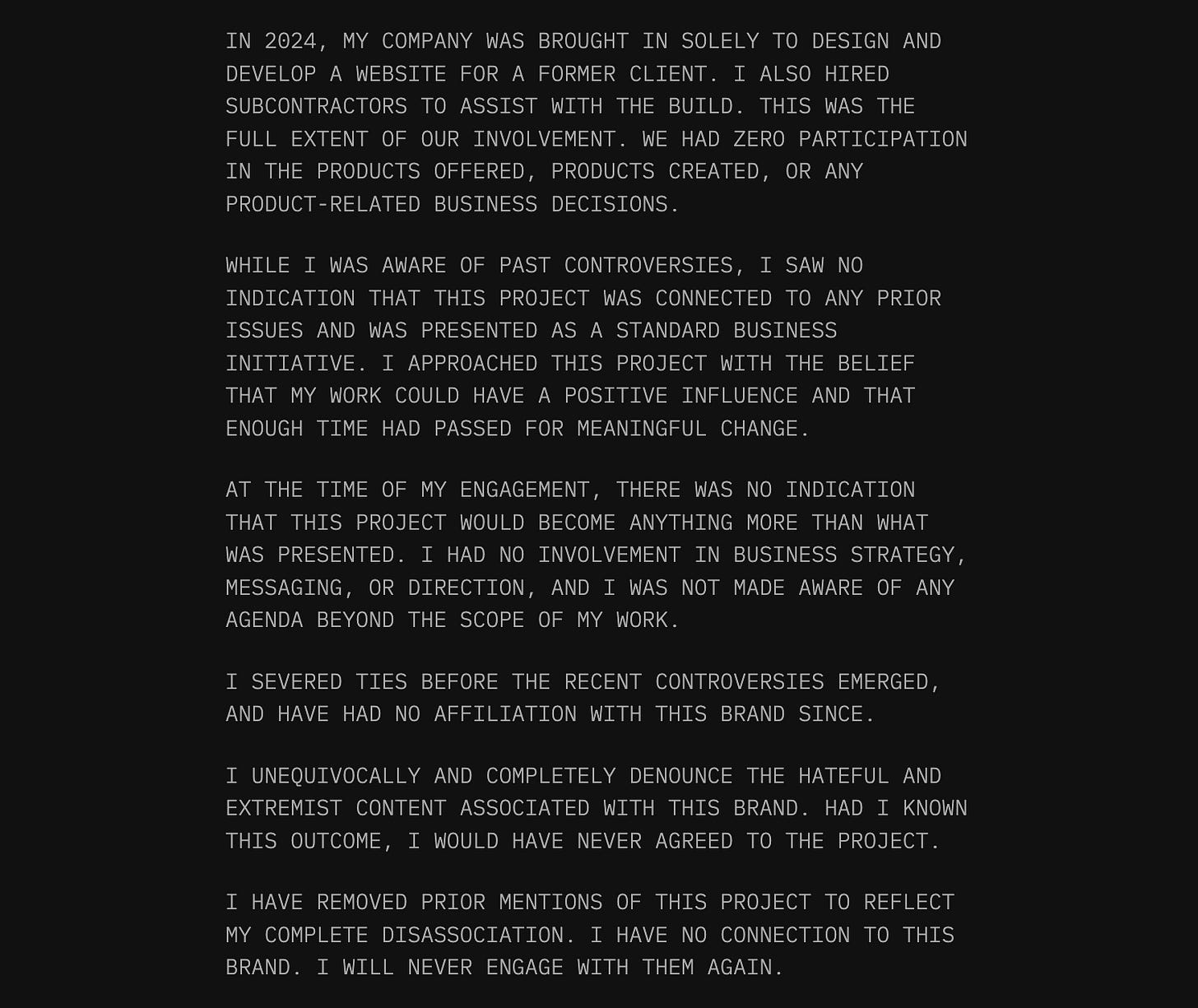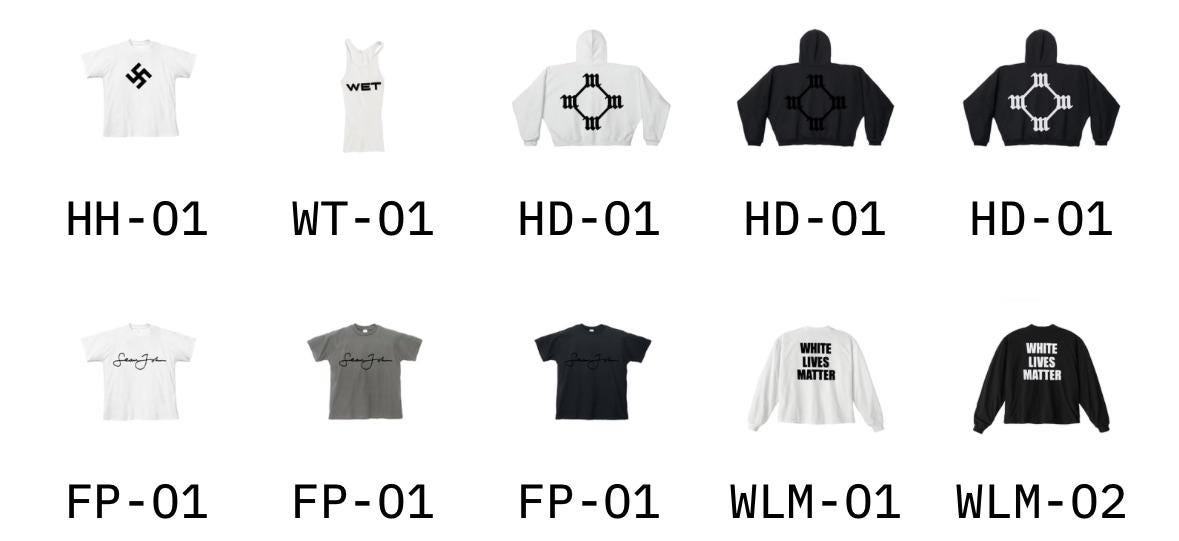Are we going to talk about the swastika merch in Kanye’s Super Bowl commercial?
Why design must refuse collateral damage brought by hate speech
“Did you see it?” I blink six hours ahead and yet blissfully unaware.
“See what?”
“Matt’s press release.”
Designers are making too many PR statements as of late, is this really necessary, I wondered. Turns out, yes. Couched in a cryptic URL from well-known web designer Matt D Smith, was a statement. Kanye West hired Smith to build a website that would debut during the 2025 Super Bowl. What would be a monumental opportunity was ruined when Kanye hijacked the project between delivery and launch to add swastika t-shirts to the storefront. Matt was now positioned squarely within the scandal.
While it is generous of Matt to offer up this story for public awareness, the opportunity is missed if we do not ask the right questions about design’s role as a vehicle for hatred.
Designers are not strictly visual people. We are not vibe makers. We are critical distributors of ideas, both hate speech and life-affirming ideas.
Oddly, Kanye and I also have beef.
From 2016-17 I was working on a project called Kanyegg, various quotes in lyrics out of multitude of eggs. There was an “omelette you finish” stuffed with cheese, a speckled “get laid” eggs nestled in rolling green grass. To this day “I make miracle whips” out of toasted meringue is still a crowd pleaser. What started as a personal project was eventually acquired by Wix. They built me a website and animated some of my static images into a clever commercial. On launch day I awoke to the infamous “slavery was a choice” tweet and was instantly sick. Immediately I called the team and we agreed to postpone the project. It was permanently axed when photos of Ye surfaced sporting a maga hat.
Celebrity-centered projects are generally a mistake. Fame and mental health issues can make anyone unpredictable, but Ye continued spiraling out of control after that. Domestic violence incidents, stalking, and hate speech erupted out of him at celebrity events and in long rants on twitter. He is a risky subject and risker client.
The Super Bowl is the golden goose of American design with almost a billion viewers glued to screens, garnering attention than any other American televised event. A design project on this stage should be the pinnacle of achievement. How easily was Smith’s website hijacked for hate symbolism. And further, why did site host Shopify take an entire twenty-hour hours to shut down nazi symbols on their product? That is twenty-three hours and thirty minutes too long.
Perhaps most disturbing is not Smith’s work being marred by pro-violence symbolism, but the design industry’s reaction. Thankfully Smith himself states “I unequivocally and completely denounce the hateful and extremist content associated with this brand. Had I known this outcome, I would have never agreed to this project.” Matt’s twitter post received hundreds of design bro replies sympathetically patting him on the back. Instead of using the event to galvanize our community against fascism, the responses were “it’s too bad, that was a good site.”

This reveal was a warning. Design is irreparably changed from here. Super Bowl regulations will constrict, restrictions will heighten. It will become harder to push through design and art in general after this. But more importantly: will designers choose to boycott brands and celebs promoting hatred? Will we do the bare minimum, affirming we don’t fuck with nazis? We live in an era where we must enthusiastically affirm we are not tolerant of hate speech and violence.
If design does not counter hate speech with equal force, it will fold through apathy and break. “Live your dream” “better together” and other platitudes are not sufficiently strong enough to counter hatred. “Black Lives Matter” was the closest counter-equivalency we’ve seen. It was everywhere, sparking new discussions about who is valuable and why.
Design is system-based thinking. Our industry is functioning perfectly, as it was built and maintained to function. All systems are subject to the universal law of entropy, meaning they naturally devolve when not properly maintained. Maintenance looks like care, critical analysis, pruning ideas and people that don’t reflect our core values. Every industry must do this to remain healthy, and design especially.
“Is this necessary? Must we spell out our allegiance to unity, inclusion, and doing what is right?” Yes. In a world where nazi signage is broadcast during a major mainstream media event, yes. In a world where our colleagues risk deportation and discrimination, yes. In a world where I regularly check on my Levant based friends to assure their houses weren’t bombed, yes.
We must hold businesses responsible for their values and their policies. They are our collaborators, and we are collateral damage in their mistakes whether we wish to be or not. Shopify did not move quickly enough or with necessary disgust in their own statements. Fuck the carelessness of that choice. Kanye is irredeemable in this current direction, and no beloved catalogue of music will salvage these high profile choices. “Separating the art from the artist” is a grace we afford too liberally to the dead. The living must prove they are worthy of their stage and legacy. Fuck Kanye’s determination to be edgy at the cost of others. And we must hold each other accountable for pushing away the critical questions that keep our industry healthy. Fuck the cowardice of “well that sucks, it was a nice site.” What are we going to do about this violation of our skills, our goodwill?
Design can save the world, but it can also bring about collapse. Let’s act like this statement is true.


